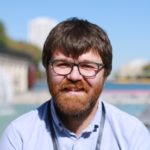Link to Pubmed [PMID] – 21694278
Link to DOI – 10.1088/0953-8984/20/20/204149
J Phys Condens Matter 2008 May; 20(20): 204149
In severe nutriment conditions, the social amoeba Dictyostelium discoideum enters a particular life cycle where it forms multicellular patterns to achieve aggregation. Extensively observed from an initial dispersed state, its developmental program can usefully be studied from a confined population to implement theoretical developments regarding biological self-organization. The challenge is then to form a cell assembly of well-defined geometrical dimensions without hindering cell behavior. To achieve this goal, we imposed transient constraints by applying temporary external magnetic gradients to trap magnetically labeled cells. Deposits of various numbers of cells were geometrically characterized for different magnetic exposure conditions. We demonstrated that the cell deposit was organized as a three-dimensional (3D) structure by both stacking layers of cells and extending these layers in the substrate plane. This structure evolves during the aggregation phase, forming periodic aggregative centers along the linear initial pattern.
